D
Dave Coster
Guest
BY THE GATES
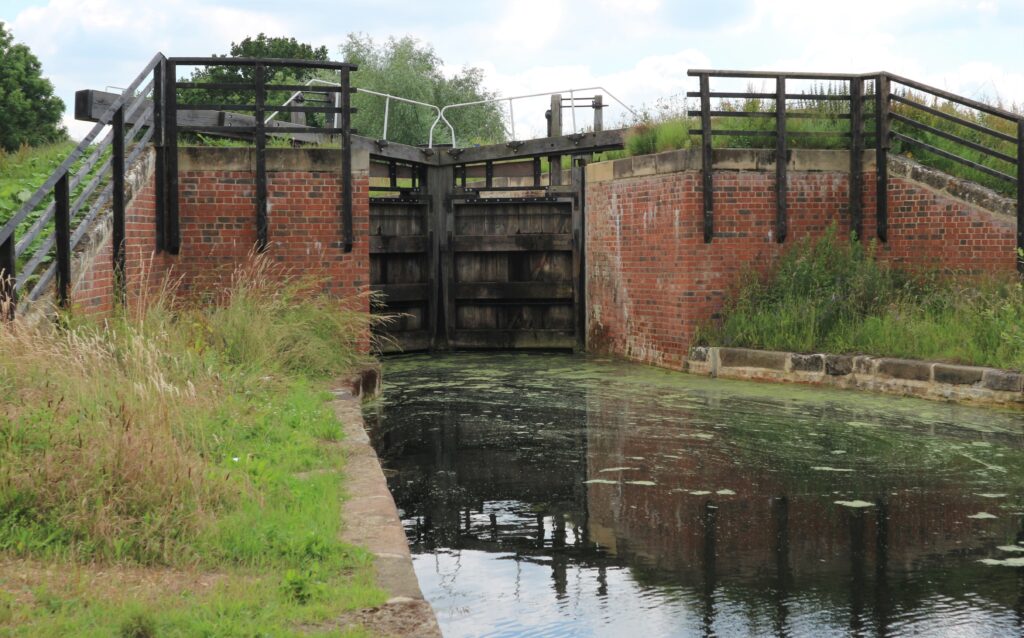
I’ve always been fascinated by the imposing locks on many of our waterways. When there is heavy boat traffic, short pounds on canals see-saw backwards and forwards all day long which, combined with passing craft, makes tackle control tricky. But I can still remember many great sessions, despite all the disturbance. Fish get used to it and even become attracted to lock structures. There are many top swims on canals and rivers around the country next to them. Water movement and all the disturbance brings food, which in turn attracts big shoals. I was pegged next to a busy lock on an important team competition many years ago, on a normally carp-dominated stretch of the Grand Union Canal at Tring. My captain informed me I was fishing for halfway in my section, but when I started bagging quality roach right from the off, I began to wonder if the impossible could happen. Amazingly it did, and my huge silver fish haul gained top points.
OPENING UP
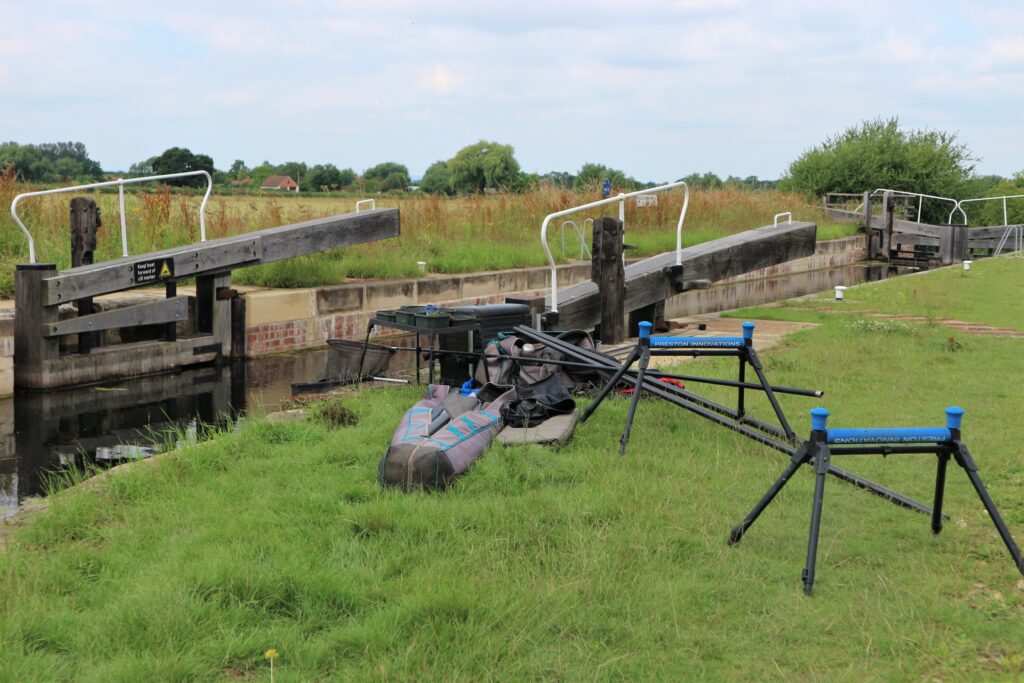
There won’t be any boats on this occasion because my local canal is still classed as disused. Work has been under way to restore the locks and dredge several of the pounds, but making Grantham accessible to watercraft from the River Trent in Nottingham again is a long way off. There isn’t even the chance of a work barge today, because the next section down has been dewatered for repair work. In case you wonder why I’ve parked my gear right next to the lock gates, the section I’m on is heavily choked with surface weed. The only fishable water is in this area. I’ve cleared the mouth of the cutting too, but I’m more interested in the deeper water inside the gates. The average depth of the canal is only 3ft to 4ft, but a plummet has just revealed a massive dropdown to 14ft inside the lock. Normally you can’t fish into the main chamber when it’s in use, but having often wondered what might live in these steep-sided places, I now intend to find out.
ON THE EDGE
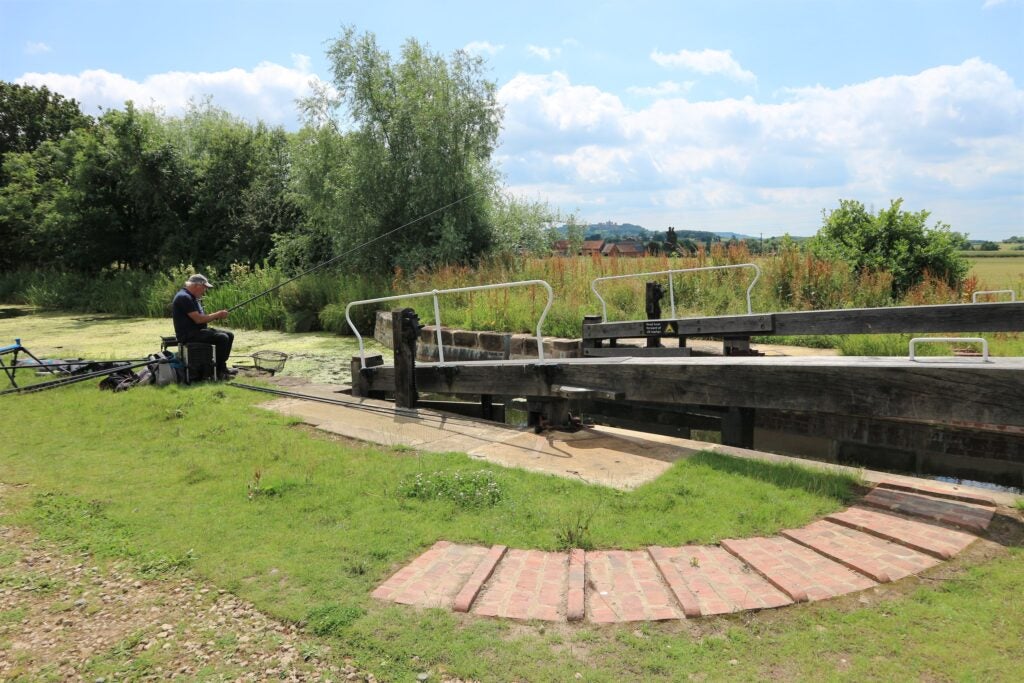
Thick surface weed is carpeting the canal to my left. Many stretches of the Grantham get like this in the summer, which is a crying shame. I suspect some fish losses occur because sunlight is blocked completely and oxygen levels become perilously low. Miraculously, some fish manage to survive and there are thankfully some surprisingly big ones, but they tend to be extremely elusive. The narrow neck of the lock cutting where I am perched is normally a good place to find fish stacked up on many canals. I remember being pegged at the end of a lock cutting on one of the famous Grand Union pounds at Watford, back in the days when I lived in London. The match was in Cassiobury Park, and I kept seeing good fish topping close to the lock gates, which were not in use that day. I quickly set up a waggler, and after catapulting casters up against the feature, started catching chub. It turned into a great day, going home with a nice fat envelope full of cash.
WORKING IN
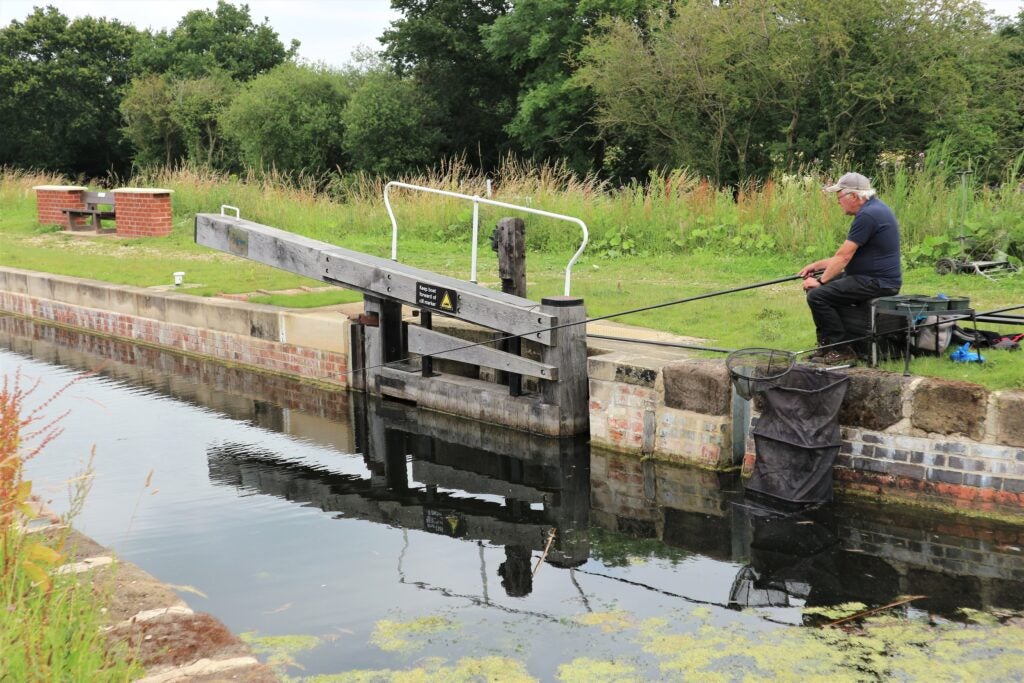
To begin with I fed three hard balls and one soft helping of dark groundbait laced with chopped worms, casters and a few red pinkies, right inside the lock – up against the far wall. It dropped down very deep here, and the bottom was uniform back to my side of the canal. I then started the session with a short pole fished to-hand style. Before I fed anything in the closer area, a single red maggot was presented over the shallower lock sill, which was around 7 feet deep. A string of small perch resulted before bites dried up. Next, I fed small balls of soft groundbait by hand, which resulted in a couple of small skimmers and a roach. I tried a short segment of worm after that and immediately hit into a good perch. This was my light rig, so I took it carefully, but the fish suddenly zigzagged into a bed of soft silk weed. It was still attached and gradually I managed to pull a big clump of it free, plus the fish. I could see the perch and it was a good one.
COMING ALIVE
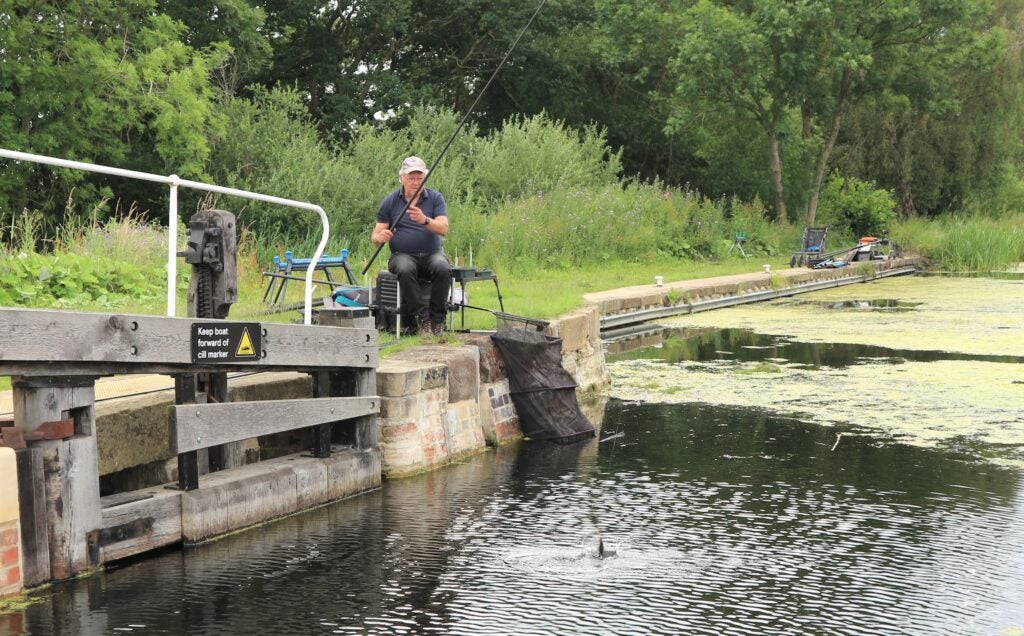
Unfortunately, just as I was reaching for my long-handled landing net, the perch kicked and shed the hook. All I was left with was lots of stringy weed, which took ages to clean off my rig. While all this was going on, I had noticed a big fizz of bubbles in between my short and long feed lines. I carried on catching a few more small perch and roach closer in, but no more skimmers or big fish. The shallow water in front of me was alive with a couple of year classes of small fry, while occasionally I could see a few bigger roach milling about deeper down. This section of the canal has been restocked recently, mainly with small skimmers and baby tench. Matches have been won with around 6lbs; either a couple of already native tench, or quality rudd. Jack pike have been a major problem, particularly on the match stretch to my left, which is now virtually unfishable. Competitions have been moved above the lock, where the weed is less bad for some reason.
NEW TERRITORY
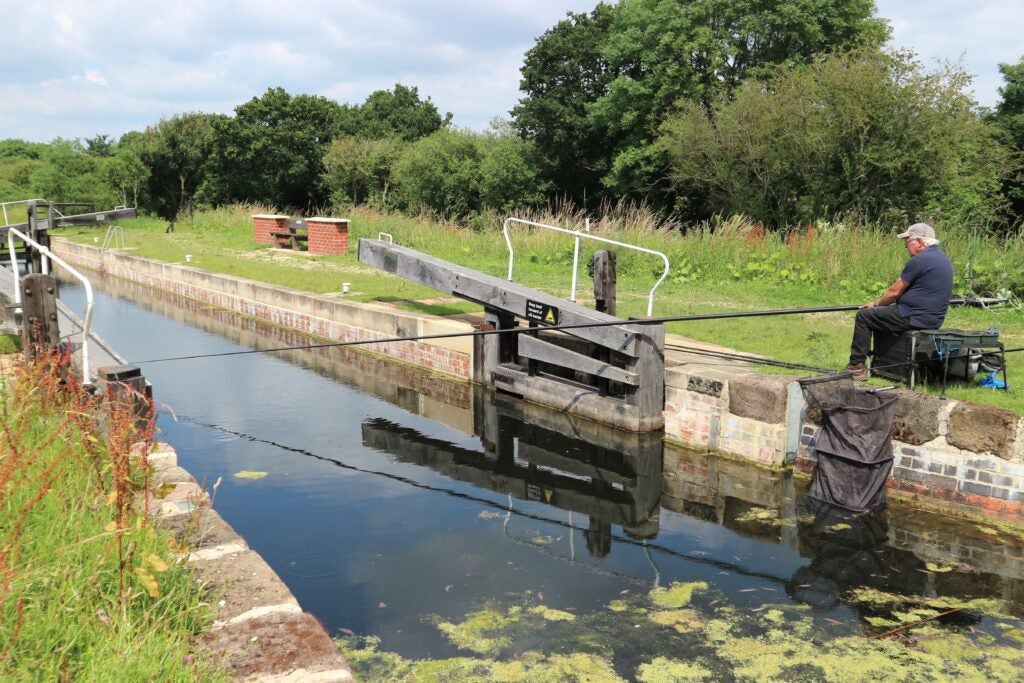
Another big fizz of bubbles over my long feed line told me it was time to bring more pole into play. Whatever was rooting about on the bottom was sending small bits of black rotting debris to the surface, along with clouds of gas bubbles. First bite and I was expecting an elastic-stretcher, instead a small perch popped out, followed by a newly stocked skimmer. It went quiet after that, so I put some more groundbait and chopped worms in and gave the deep water swim a rest. I had another go on the short pole, but found that had slowed too, apart from tiny fish nibbling the hook bait. I reflected on how this lock was only rebuilt a couple of years ago, while the next one up was completed even faster last year. I’m still quite new to the area and local anglers tell me I have missed the golden times. Well known anglers like Frank Barlow used to fish along here, and reckoned every peg held several good tench back then. Sadly, not the case now.
GOING LARGE
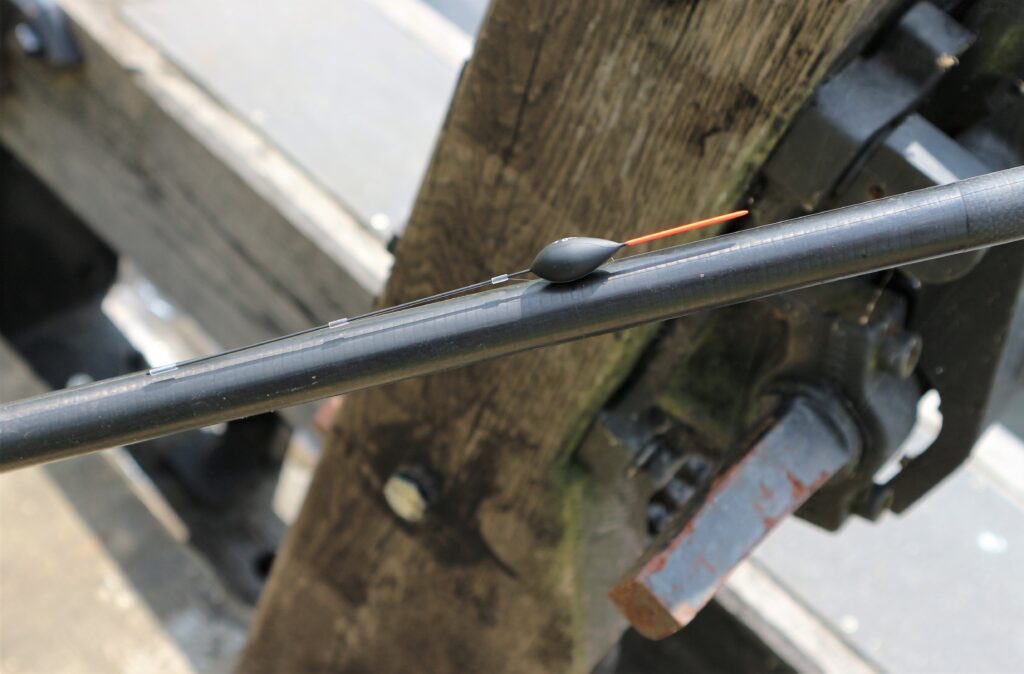
I would normally be using small pole floats on the towpath of shallow canals like this one, such as 0.2g or 0.3g sizes. But fishing in the lock required something much bigger. I set up this 0.75g float for fishing to-hand over the sill, with a strung bulk of number 8s and three number 11s spread out below. The extra weight was needed to swing the tackle out with a top 4 kit. My longer rig was even heavier at 1.25g, with an olivette bulk on another top 4. The last time I could remember fishing like this on a cut was way back on the Silstar Pole Championships, held on the deep Gloucester Canal. I came third with a nice bag of quality roach. I had started on bloodworm, but the England International next to me was ace at that type of fishing, so I switched to loose feeding maggots over the top. The change of tactics eventually attracted big roach. Sadly, I lost a good chub at the landing net in the dying minutes, which cost me the match and the title.
CHASING BUBBLES
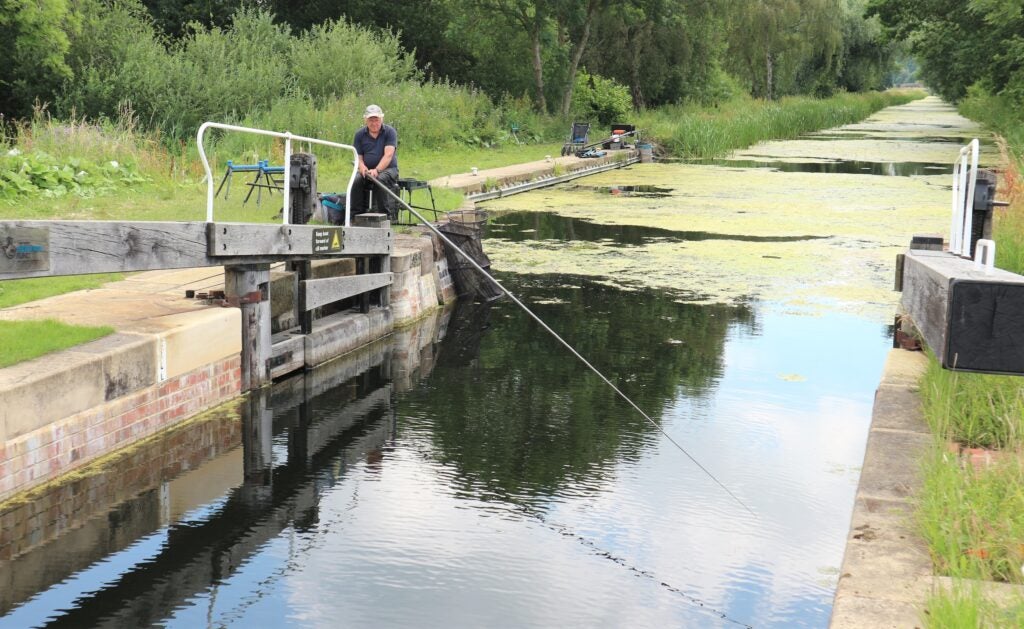
Yet again another big cluster of bubbles erupted over my far feed line, so I settled down with the long pole and my deep rig for the rest of the session. I tried working the tackle around where I had fed, occasionally catapulting out a few casters. Tiny roach responded to a single red maggot, nothing at all on caster and small perch on bits of worm. I stuck with worm. A couple of club members dropped by, chatting about what had been happening on the evening matches, along with commenting on the declining state of the venue due to the weed. Next, a big party of local school kids had a break from their walk at the other end of the lock, making lots of noise. A few stones were thrown in, but I didn’t say anything because they wouldn’t understand, plus it was nice to see their teachers getting them out in the countryside. All part of fishing canals. At least the dreaded speeding towpath biker syndrome isn’t yet a problem in this area.
WAKE UP CALL
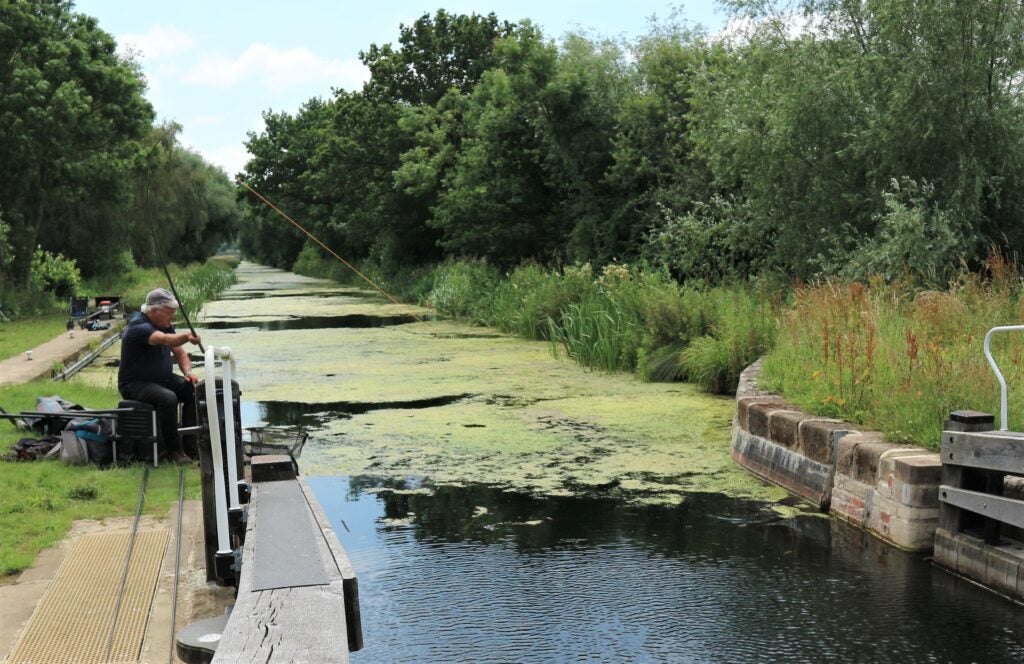
The kids finally departed and peace returned. No signs of the bubbler after all that racket. I sat there watching my float not doing anything and more lock memories came flooding back. In my early club fishing days a few of us used to hire a cruiser on the Thames at Bourne End. We explored the river upstream, travelling past Oxford into the beyond. We fished all the inaccessible places and caught loads. I remember the lock keeper at Marlow light-heartedly telling me off after entering his lock with our boat pointing backwards! There’s a tricky side current as you approach and the damned craft wouldn’t do what I wanted. Early mornings, if you were the first boat through a lock, it was amazing to see the amount of fish in them. Shoals of bleak and dace on top, with the dark shapes of chub cruising deeper down. All the reminiscing suddenly got interrupted, my float disappeared, my pole elastic shot out and something big charged towards me.
DEEP TROUBLE
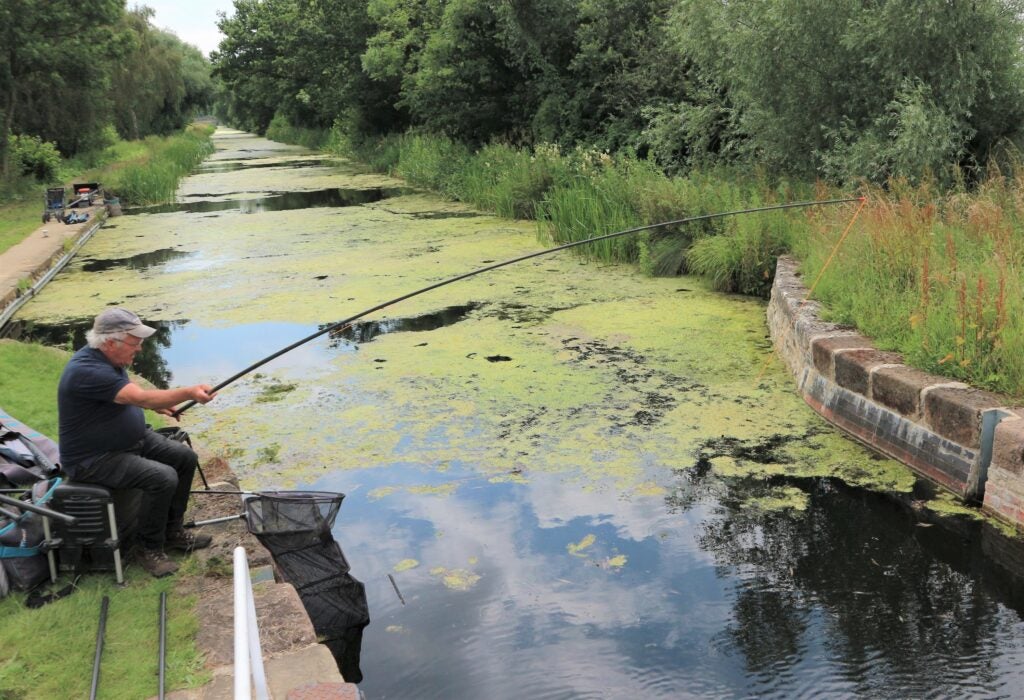
The only thing I hadn’t reckoned for fishing so deep was what to do if a good fish swam out of the lock into shallow water. That’s exactly what happened. It charged out to my left and shot under all the weed. It was difficult to get any control because with my float set at 14ft and with another 14 inches of line above that, I couldn’t break my pole down to get at the puller bung, which was two sections above me. I had to take a gamble and let off the tension for a few seconds, reaching up and grabbing the small anchor bead. I quickly stripped a lot of elastic out of the top kit and the sudden increase in tension on the shock absorber seemed to help. Although the fish was weeded up, I could still feel it thumping around. Slowly, as I gained even more of the hybrid elastic, I could see a nice tench, wearing a big clump of debris like a cap over its head. I was only using a small medium wire hook and 0.10mm trace line, but thankfully everything held.
DICEY MOMENTS
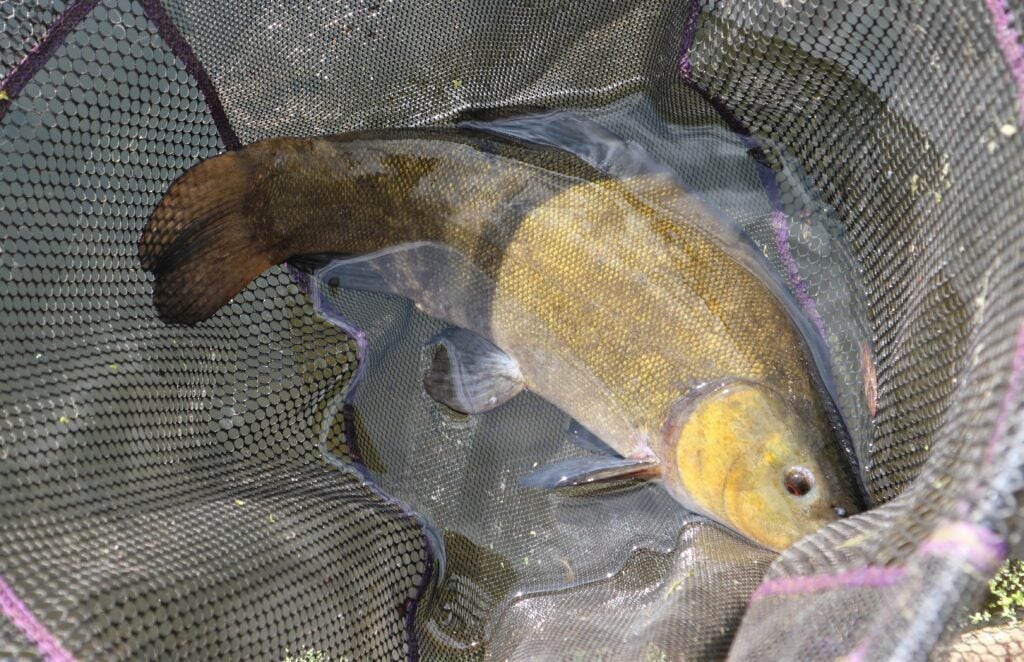
When tench weed your tackle, one of two things normally happens. They either expertly transfer the hook into whatever they have hit into, or suddenly give up the ghost when their heads get covered. Luckily for me it was to be the latter case on this occasion. Even better, as I slid the net under the fish, all the underwater greenery fell away, back into the canal. I’ve had a few lucky escapes like this before and just as many disappointing disasters. A few days previously I had been after tench on a club lake, catching plenty but annoyingly losing several of the bigger fish I hooked. There was lots of horrible black stringy weed on the bottom, too deep to see. But of course the fish knew where it was, charging through it and dislodging the hook. I was still getting over losing one particularly big fish, so it made me even happier getting this one into the landing net. It was nowhere near as big as the lake monster I had lost, but still a great size for a canal.
WEEDED OFF
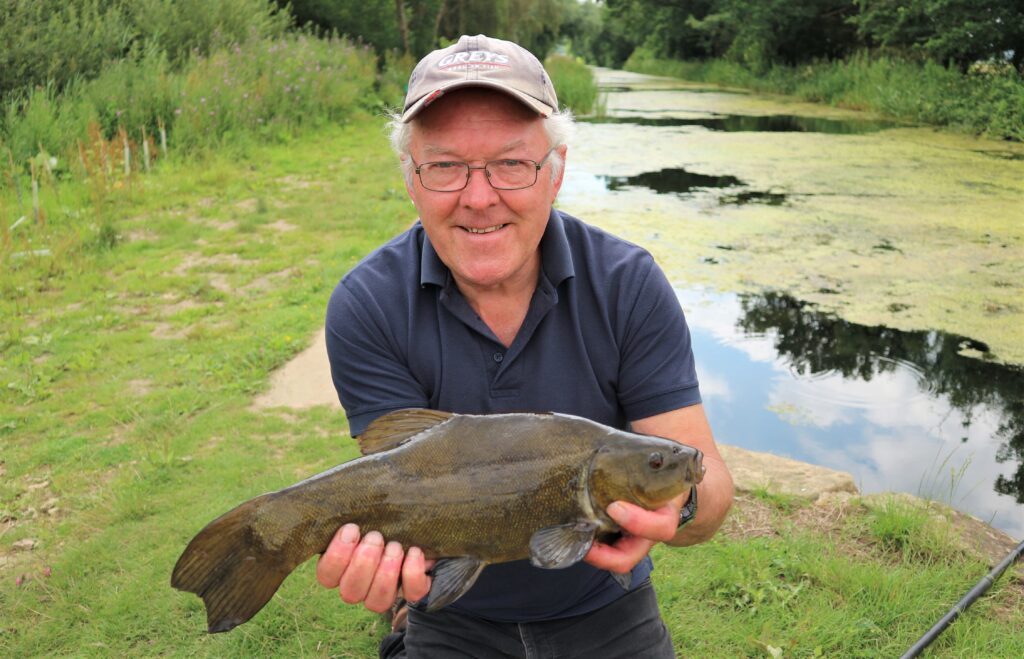
It was interesting finding out what was inhabiting the normally out-of-bounds deeps in a lock. I was more than pleased with this canal warrior, which is a canny survivor considering the tough environment it has been existing in. A couple of years ago, the spot where I caught this fish from was dry land while the lock was being totally rebuilt. Most of the people doing this work are volunteers, so many thanks for their hard efforts. I just wish something could be done to keep the water quality better and the weed in check, allowing more anglers to enjoy catching fish like this. I also caught a few pounds of small stuff and there was an amazing amount of fry buzzing around the entrance to the lock. It’s the heart of summer now, and much of the Grantham end of the towpath is completely unfishable. Miles and miles are choked solid with thick duckweed. I’ve enjoyed a few good sessions down that end, but this year it’s looking like a complete wash-out.
The post Lock Stories first appeared on FishingMagic Magazine.
Continue reading...

I’ve always been fascinated by the imposing locks on many of our waterways. When there is heavy boat traffic, short pounds on canals see-saw backwards and forwards all day long which, combined with passing craft, makes tackle control tricky. But I can still remember many great sessions, despite all the disturbance. Fish get used to it and even become attracted to lock structures. There are many top swims on canals and rivers around the country next to them. Water movement and all the disturbance brings food, which in turn attracts big shoals. I was pegged next to a busy lock on an important team competition many years ago, on a normally carp-dominated stretch of the Grand Union Canal at Tring. My captain informed me I was fishing for halfway in my section, but when I started bagging quality roach right from the off, I began to wonder if the impossible could happen. Amazingly it did, and my huge silver fish haul gained top points.
OPENING UP

There won’t be any boats on this occasion because my local canal is still classed as disused. Work has been under way to restore the locks and dredge several of the pounds, but making Grantham accessible to watercraft from the River Trent in Nottingham again is a long way off. There isn’t even the chance of a work barge today, because the next section down has been dewatered for repair work. In case you wonder why I’ve parked my gear right next to the lock gates, the section I’m on is heavily choked with surface weed. The only fishable water is in this area. I’ve cleared the mouth of the cutting too, but I’m more interested in the deeper water inside the gates. The average depth of the canal is only 3ft to 4ft, but a plummet has just revealed a massive dropdown to 14ft inside the lock. Normally you can’t fish into the main chamber when it’s in use, but having often wondered what might live in these steep-sided places, I now intend to find out.
ON THE EDGE

Thick surface weed is carpeting the canal to my left. Many stretches of the Grantham get like this in the summer, which is a crying shame. I suspect some fish losses occur because sunlight is blocked completely and oxygen levels become perilously low. Miraculously, some fish manage to survive and there are thankfully some surprisingly big ones, but they tend to be extremely elusive. The narrow neck of the lock cutting where I am perched is normally a good place to find fish stacked up on many canals. I remember being pegged at the end of a lock cutting on one of the famous Grand Union pounds at Watford, back in the days when I lived in London. The match was in Cassiobury Park, and I kept seeing good fish topping close to the lock gates, which were not in use that day. I quickly set up a waggler, and after catapulting casters up against the feature, started catching chub. It turned into a great day, going home with a nice fat envelope full of cash.
WORKING IN

To begin with I fed three hard balls and one soft helping of dark groundbait laced with chopped worms, casters and a few red pinkies, right inside the lock – up against the far wall. It dropped down very deep here, and the bottom was uniform back to my side of the canal. I then started the session with a short pole fished to-hand style. Before I fed anything in the closer area, a single red maggot was presented over the shallower lock sill, which was around 7 feet deep. A string of small perch resulted before bites dried up. Next, I fed small balls of soft groundbait by hand, which resulted in a couple of small skimmers and a roach. I tried a short segment of worm after that and immediately hit into a good perch. This was my light rig, so I took it carefully, but the fish suddenly zigzagged into a bed of soft silk weed. It was still attached and gradually I managed to pull a big clump of it free, plus the fish. I could see the perch and it was a good one.
COMING ALIVE

Unfortunately, just as I was reaching for my long-handled landing net, the perch kicked and shed the hook. All I was left with was lots of stringy weed, which took ages to clean off my rig. While all this was going on, I had noticed a big fizz of bubbles in between my short and long feed lines. I carried on catching a few more small perch and roach closer in, but no more skimmers or big fish. The shallow water in front of me was alive with a couple of year classes of small fry, while occasionally I could see a few bigger roach milling about deeper down. This section of the canal has been restocked recently, mainly with small skimmers and baby tench. Matches have been won with around 6lbs; either a couple of already native tench, or quality rudd. Jack pike have been a major problem, particularly on the match stretch to my left, which is now virtually unfishable. Competitions have been moved above the lock, where the weed is less bad for some reason.
NEW TERRITORY

Another big fizz of bubbles over my long feed line told me it was time to bring more pole into play. Whatever was rooting about on the bottom was sending small bits of black rotting debris to the surface, along with clouds of gas bubbles. First bite and I was expecting an elastic-stretcher, instead a small perch popped out, followed by a newly stocked skimmer. It went quiet after that, so I put some more groundbait and chopped worms in and gave the deep water swim a rest. I had another go on the short pole, but found that had slowed too, apart from tiny fish nibbling the hook bait. I reflected on how this lock was only rebuilt a couple of years ago, while the next one up was completed even faster last year. I’m still quite new to the area and local anglers tell me I have missed the golden times. Well known anglers like Frank Barlow used to fish along here, and reckoned every peg held several good tench back then. Sadly, not the case now.
GOING LARGE

I would normally be using small pole floats on the towpath of shallow canals like this one, such as 0.2g or 0.3g sizes. But fishing in the lock required something much bigger. I set up this 0.75g float for fishing to-hand over the sill, with a strung bulk of number 8s and three number 11s spread out below. The extra weight was needed to swing the tackle out with a top 4 kit. My longer rig was even heavier at 1.25g, with an olivette bulk on another top 4. The last time I could remember fishing like this on a cut was way back on the Silstar Pole Championships, held on the deep Gloucester Canal. I came third with a nice bag of quality roach. I had started on bloodworm, but the England International next to me was ace at that type of fishing, so I switched to loose feeding maggots over the top. The change of tactics eventually attracted big roach. Sadly, I lost a good chub at the landing net in the dying minutes, which cost me the match and the title.
CHASING BUBBLES

Yet again another big cluster of bubbles erupted over my far feed line, so I settled down with the long pole and my deep rig for the rest of the session. I tried working the tackle around where I had fed, occasionally catapulting out a few casters. Tiny roach responded to a single red maggot, nothing at all on caster and small perch on bits of worm. I stuck with worm. A couple of club members dropped by, chatting about what had been happening on the evening matches, along with commenting on the declining state of the venue due to the weed. Next, a big party of local school kids had a break from their walk at the other end of the lock, making lots of noise. A few stones were thrown in, but I didn’t say anything because they wouldn’t understand, plus it was nice to see their teachers getting them out in the countryside. All part of fishing canals. At least the dreaded speeding towpath biker syndrome isn’t yet a problem in this area.
WAKE UP CALL

The kids finally departed and peace returned. No signs of the bubbler after all that racket. I sat there watching my float not doing anything and more lock memories came flooding back. In my early club fishing days a few of us used to hire a cruiser on the Thames at Bourne End. We explored the river upstream, travelling past Oxford into the beyond. We fished all the inaccessible places and caught loads. I remember the lock keeper at Marlow light-heartedly telling me off after entering his lock with our boat pointing backwards! There’s a tricky side current as you approach and the damned craft wouldn’t do what I wanted. Early mornings, if you were the first boat through a lock, it was amazing to see the amount of fish in them. Shoals of bleak and dace on top, with the dark shapes of chub cruising deeper down. All the reminiscing suddenly got interrupted, my float disappeared, my pole elastic shot out and something big charged towards me.
DEEP TROUBLE

The only thing I hadn’t reckoned for fishing so deep was what to do if a good fish swam out of the lock into shallow water. That’s exactly what happened. It charged out to my left and shot under all the weed. It was difficult to get any control because with my float set at 14ft and with another 14 inches of line above that, I couldn’t break my pole down to get at the puller bung, which was two sections above me. I had to take a gamble and let off the tension for a few seconds, reaching up and grabbing the small anchor bead. I quickly stripped a lot of elastic out of the top kit and the sudden increase in tension on the shock absorber seemed to help. Although the fish was weeded up, I could still feel it thumping around. Slowly, as I gained even more of the hybrid elastic, I could see a nice tench, wearing a big clump of debris like a cap over its head. I was only using a small medium wire hook and 0.10mm trace line, but thankfully everything held.
DICEY MOMENTS

When tench weed your tackle, one of two things normally happens. They either expertly transfer the hook into whatever they have hit into, or suddenly give up the ghost when their heads get covered. Luckily for me it was to be the latter case on this occasion. Even better, as I slid the net under the fish, all the underwater greenery fell away, back into the canal. I’ve had a few lucky escapes like this before and just as many disappointing disasters. A few days previously I had been after tench on a club lake, catching plenty but annoyingly losing several of the bigger fish I hooked. There was lots of horrible black stringy weed on the bottom, too deep to see. But of course the fish knew where it was, charging through it and dislodging the hook. I was still getting over losing one particularly big fish, so it made me even happier getting this one into the landing net. It was nowhere near as big as the lake monster I had lost, but still a great size for a canal.
WEEDED OFF

It was interesting finding out what was inhabiting the normally out-of-bounds deeps in a lock. I was more than pleased with this canal warrior, which is a canny survivor considering the tough environment it has been existing in. A couple of years ago, the spot where I caught this fish from was dry land while the lock was being totally rebuilt. Most of the people doing this work are volunteers, so many thanks for their hard efforts. I just wish something could be done to keep the water quality better and the weed in check, allowing more anglers to enjoy catching fish like this. I also caught a few pounds of small stuff and there was an amazing amount of fry buzzing around the entrance to the lock. It’s the heart of summer now, and much of the Grantham end of the towpath is completely unfishable. Miles and miles are choked solid with thick duckweed. I’ve enjoyed a few good sessions down that end, but this year it’s looking like a complete wash-out.
The post Lock Stories first appeared on FishingMagic Magazine.
Continue reading...
